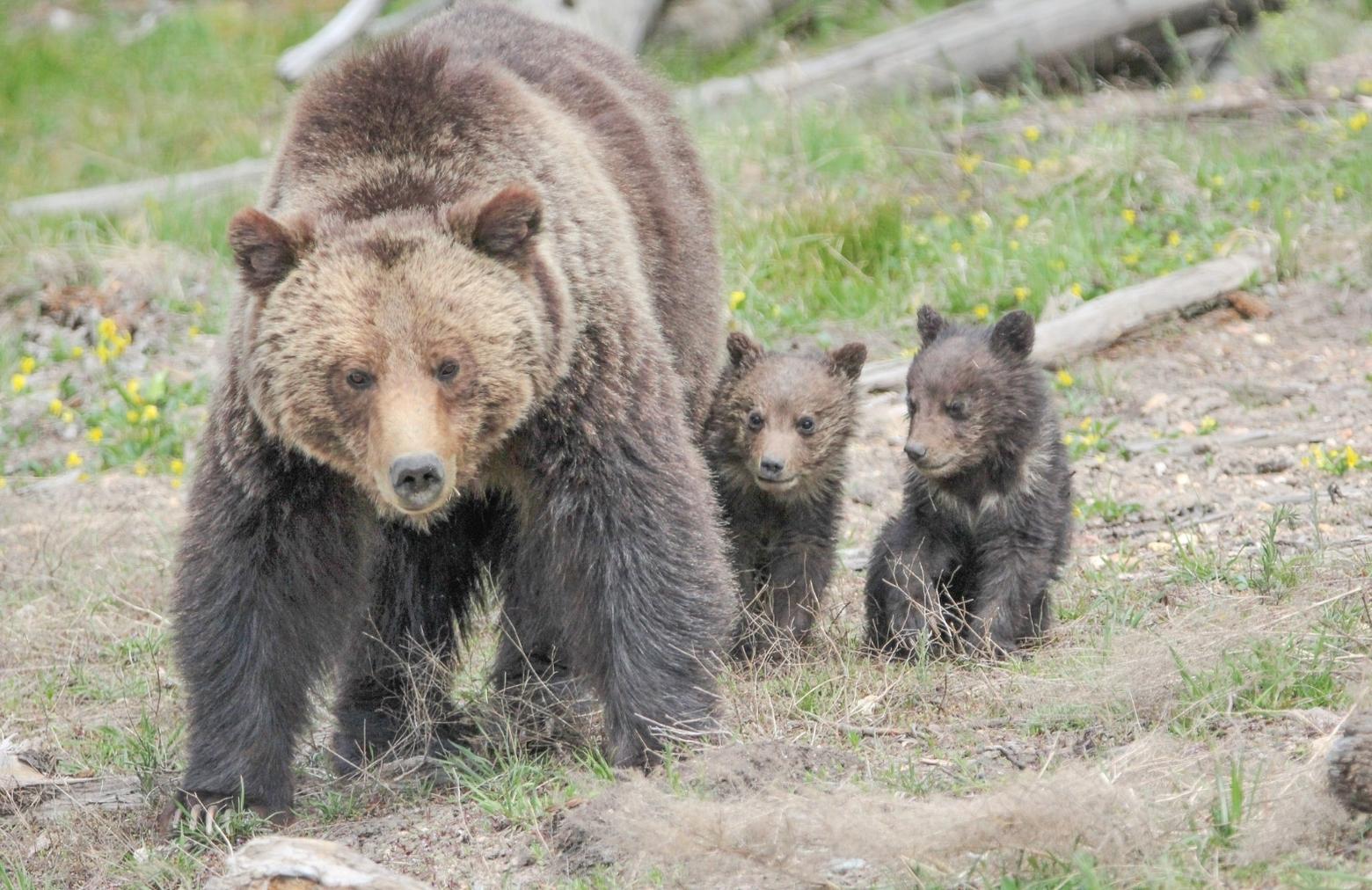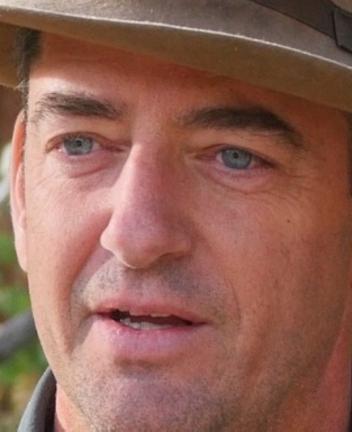Back to StoriesEncounter With Grizzly—Part I: The Shooting
July 5, 2018
Encounter With Grizzly—Part I: The ShootingIn three parts, MoJo columnist Steve Primm reflects on lessons from a hiker's killing of a bear in Wyoming's Wind River Mountains
On the last day of May 2018, four young men and a curious dog crossed paths with a mother grizzly and her two new cubs in Wyoming’s Wind River Mountains.
The dog – a 75-pound retriever mix – approached the grizzly family. The mother bear probably saw the dog as a threat to her cubs. She did what grizzlies do when they encounter danger: respond with ferocious, defensive aggression.
Two of the men carried bear spray, but they trailed behind the other two by 50 yards. The mother grizzly’s charge carried her to within five yards of the men in the lead, then she stopped. One of the hikers then ran as she bore down on them. The other held his ground. He drew a .460 S&W revolver, an anvil of a weapon that holds cartridges nearly the size of your thumb. For what must have seemed an eternity, he told me, they both stood still.
Facing a powerful, agitated carnivore – one that has been shaped by half a million years of evolution to prevail by overwhelming force – our primitive, fight-or-flight components take over. Under those conditions, we don’t weigh the odds, we don’t ponder over ethics, or think about what kind of world we want to leave our great grandchildren. We react.
The man pulled the trigger. Packing over a ton of energy, the bullet would’ve knocked the grizzly backward. He fired again, he said, to end her suffering. There would be no second chance, no lessons learned about two-leggeds for this grizzly family. The cubs, in their first season of life, are almost certainly doomed without their mother.
These awful, deadly conflicts occur several times annually. Having spent 25 years working to improve grizzly-human coexistence, I have a well-worn emotional routine that I go through each time this happens: Mourn, rage, blame if I need to. But being stuck in an anger rut ultimately doesn’t work for me. I focus instead on learning from this and other deadly run-ins between people and grizzly bears.
Mountain Journal asked me to explore the thought process in a series of columns.
The man who shot the mother grizzly actually initiated a remarkable interview with the Jackson Hole News & Guide. He expressed deep remorse and wished that he had chosen to carry bear spray instead of a firearm that day. And while he and his friends did some things right – travelling in a group of four, with two of them carrying bear spray – their experience points to a broader problem, especially as more and more people venture into grizzly country every year.
That problem: lack of preparedeness, especially on a mental level.
That the casualty happened in the wild Wind Rivers where grizzlies have been recolonizing following many decades of human-caused extirpation is its own topic.
° ° °
Most of us are in grizzly country to have fun – to hike, fish, bicycle, hunt, or see wildflowers. Undifferentiated terror and hypervigilance usually get in the way of fun, and no credible bear safety expert would try to scare you into staying on the pavement. It’s worth noting that millions of people pass through the grizzly-bear inhabited Greater Yellowstone Ecosystem each year, most gracing only the front-country, with fewer penetrating more than a mile from a paved road. Only a tiny number will have a frightening encounter with a bear.
Many people, though, either thoroughly discount the risk of an encounter, or are in denial about the need to prepare.
We can borrow insights from neuroscience to better understand how we’re going to behave in a survival stress scenario, like meeting a grizzly. Adrenaline surges, our alertness peaks, and we narrow our focus to the thing that’s threatening us. Our decision-making will default to (quite literally) shoot first, ask questions later.
Anything you would hope to do in a grizzly encounter – such as effectively using bear spray, and not panic and run – you better have practiced until it’s familiar enough to override panicked reactions. In other words, it can be difficult to keep your cool if you haven’t mentally prepared yourself for how to do it.
Anything you would hope to do in a grizzly encounter – such as effectively using bear spray, and not panic and run – you better have practiced until it’s familiar enough to override panicked reactions. In other words, it can be difficult to keep your cool if you haven’t mentally prepared yourself for how to do it.
I am, apart from my work in conservation, a volunteer first responder. People who deal with high-paced, high stress situations regularly – SWAT, trauma nurses, firefighters – are given to quoting the ancient Greek philosopher Archilochus: “We don’t rise to the level of our expectations, we fall to the level of our training.”
Another thing that happens in survival stress situations: blood rushes to major muscle groups to prime ourselves for fight or flight. As a trade-off, our fine motor skills degrade considerably. If you’re not proficient with the thumb/forefinger move necessary to pop the safety wedge off your bear spray, don’t expect to magically get good at it in the face of a charging grizzly.
What’s important to do? Practice: get an empty bear spray can, or an inert training can, and practice popping that safety off until you could do it half asleep, in the dark, with cold fingers. Practice putting your hand on your holstered bear spray until it’s as automatic as scratching your ear.
It’s interesting. States require that young hunters go through safety courses. We have no equivalent for people traversing grizzly country yet it’s an invaluable skill.
Dangerous encounters with grizzly bears happen very fast. A charging grizzly will cover about 15 yards per second. If a bear charges from about 50 yards, she will reach you in just over three seconds. The young man in the Wind Rivers instinctively knew that the grizzly he faced could cover that last five yards in the blink of an eye.
Take out your smartphone and have a friend time you while you rehearse unholstering, removing the safety, and spraying bear spray. Some seasoned, proficient folks can spray in about two seconds. With practice, you should be able to spray in under three seconds. Add roughly half a second for the bear spray to whoosh out to its maximum range of about 10 yards (far less in unfavorable wind conditions). [Read also Mountain Journal's story: To Live Or Die In Bear Country: Counting The Seconds In Your Grizzly Moment Of Truth].
If you are following the numbers here, you’ve noted that spraying in three seconds gives you no cushion of space or time on grizzly charging from 50 yards or less. Ideally, a charging bear would collide with your cloud of incapacitating bear spray as far away from you as possible. It will take a moment for bear spray to act on the bear’s eyes and respiratory system, and the bear will need enough space to stop without running into you.
On close-range charges, it’ll be tough to spray fast enough to prevent contact. The equation is stark: a charging grizzly traveling 15 yards per second toward a person needing three seconds to launch a deterrent cloud into the bear’s path. Closer than 50 yards, the numbers don’t work in our favor. Bear spray delivered at arm’s length will still make a big difference, but it won’t be maximally effective.
There are two clear implications: first, we must do our best to avoid close-range encounters in the first place, which I’ll explore in the next column. And second, we need to practice and drill and be prepared in case we do have a close-range grizzly encounter.
In broad strokes, though, the best strategy is to avoid encounters altogether; and have a well-practiced response plan in case you do in end up in an encounter.
The four men hiking in the Wind River mountains that day didn’t have much of a plan. They had two cans of bear spray, a big revolver, and an off-leash dog. Beyond choosing more bear spray over the handgun, the group would have benefitted from some basic pre-planning.
Ideally, each member of the group would have had bear spray, and some familiarity with using it effectively. They would have paced themselves to stay together as a tighter group and would’ve rehearsed what they would do in an encounter.
Montana hunters Marty Hoffman and Greg Benjamin shared some hard-earned lessons about dealing with grizzly encounters in a 2016 video, below. [Disclosure: the video was produced by People and Carnivores, a conservation organization devoted to preventing/reducing negative encounters between humans and carnivores. I work for People and Carnivores as a conservation director].
Benjamin describes their mental preparation: “We always had the ‘what-if’ scenarios: What if we ran into a bear, what if that bear was right there, what would we do?”
Hoffman elaborates: "I'm going to come up on [Greg's] right side; if the trail is narrow, you take that one step to the left and I come up on the right and we're shoulder to shoulder. What we've done there is make ourselves twice as big and we're both ready to deploy bear spray."
Hoffman and Benjamin know what they're talking about: they used that exact technique to repel a grizzly that came charging at them off an elk carcass in the Gallatin Range south of Bozeman. They also survived an injury encounter with a protective mother grizzly in the Madison Range, an incident that underscored the importance of a good first aid kit and survival skills.
And then there is the issue of hiking with four-legged companions off leash.
The dog was likely a contributing factor in the Wind River encounter. The mother grizzly probably felt the need to drive the dog away from her cubs. Had the dog been leashed, or under bomb-proof voice control, it could've been prevented from approaching the grizzly family. It's a rare dog that's actually an asset in grizzly country, and even those animals should be closely monitored. It is illegal for dogs to harass wildlife.
Grizzly country is some of the ruggedest, most spectacular land we can explore in America. People will continue to pour into these landscapes in ever-increasing numbers. We're at the point where we need to confront the limits of how many people can safely and sustainably share space with grizzlies. As we anticipate those limits, we have to find ways to up our game, to make our collective impact less damaging to these magnificent beings.
EDITOR'S NOTE: In his next column, Primm will offer suggestions for how to avoid close-range encounters with grizzly bears.
Related Stories
November 1, 2017
When An Off-Duty Game Warden Kills A Grizzly
After a mother grizzly with three cubs is shot in Wyoming, critics wonder why the person, who invoked self-defense, didn't use...
September 23, 2017
Grizzlies Deserve More Than Bullets
Phil Knight saw his first Yellowstone grizzly 35 years ago. After watching bear numbers climb, he says recovery should not be...
September 12, 2017
Of Bias And Bears: Is Delisting Greater Yellowstone's Grizzlies Based On Science Or Politics?
For several decades, Jesse Logan gained renown as a forest ecologist. He says the scientific rationale behind removing bears from federal...




